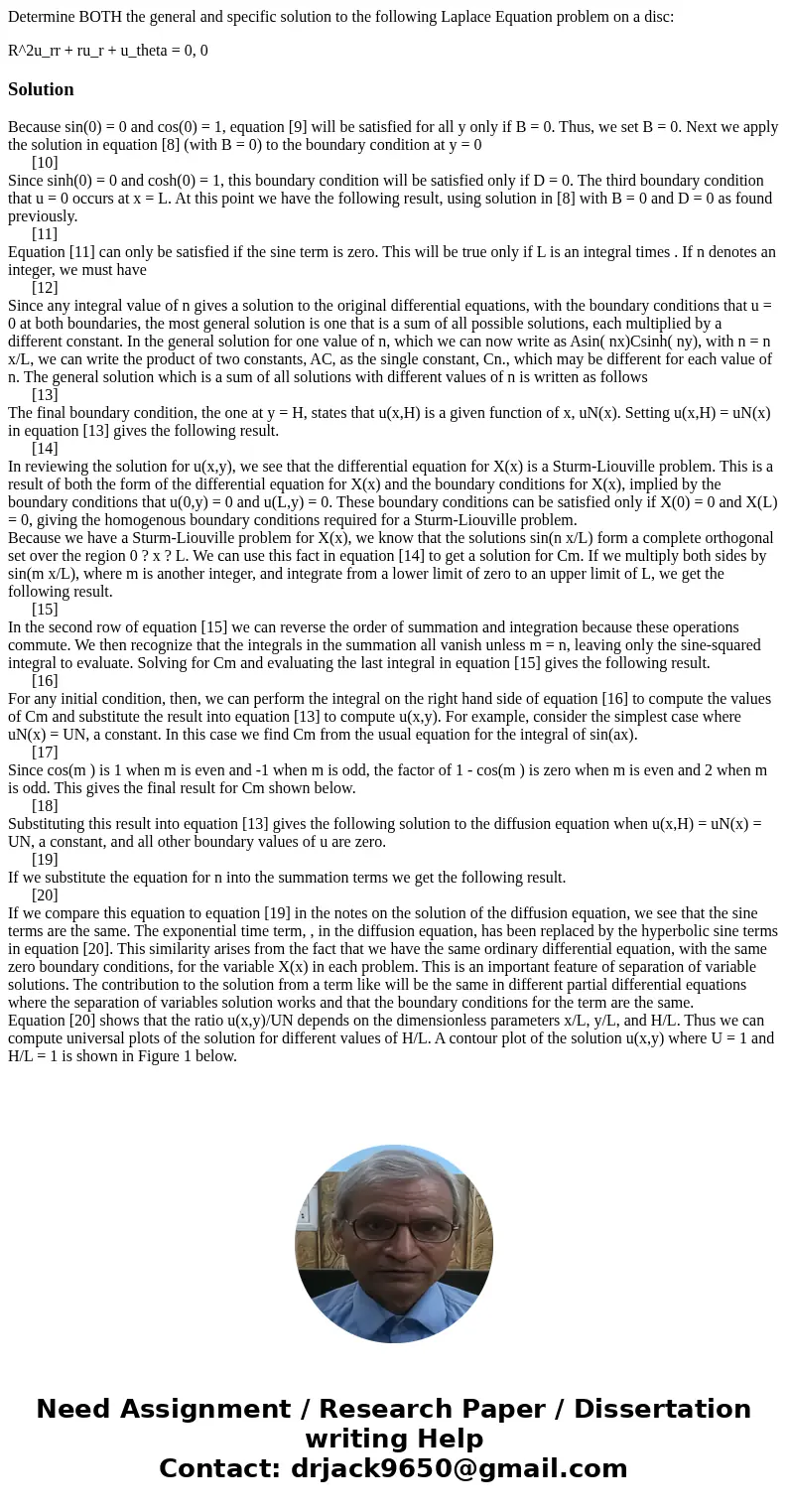Determine BOTH the general and specific solution to the foll
Determine BOTH the general and specific solution to the following Laplace Equation problem on a disc:
R^2u_rr + ru_r + u_theta = 0, 0Solution
Because sin(0) = 0 and cos(0) = 1, equation [9] will be satisfied for all y only if B = 0. Thus, we set B = 0. Next we apply the solution in equation [8] (with B = 0) to the boundary condition at y = 0
[10]
Since sinh(0) = 0 and cosh(0) = 1, this boundary condition will be satisfied only if D = 0. The third boundary condition that u = 0 occurs at x = L. At this point we have the following result, using solution in [8] with B = 0 and D = 0 as found previously.
[11]
Equation [11] can only be satisfied if the sine term is zero. This will be true only if L is an integral times . If n denotes an integer, we must have
[12]
Since any integral value of n gives a solution to the original differential equations, with the boundary conditions that u = 0 at both boundaries, the most general solution is one that is a sum of all possible solutions, each multiplied by a different constant. In the general solution for one value of n, which we can now write as Asin( nx)Csinh( ny), with n = n x/L, we can write the product of two constants, AC, as the single constant, Cn., which may be different for each value of n. The general solution which is a sum of all solutions with different values of n is written as follows
[13]
The final boundary condition, the one at y = H, states that u(x,H) is a given function of x, uN(x). Setting u(x,H) = uN(x) in equation [13] gives the following result.
[14]
In reviewing the solution for u(x,y), we see that the differential equation for X(x) is a Sturm-Liouville problem. This is a result of both the form of the differential equation for X(x) and the boundary conditions for X(x), implied by the boundary conditions that u(0,y) = 0 and u(L,y) = 0. These boundary conditions can be satisfied only if X(0) = 0 and X(L) = 0, giving the homogenous boundary conditions required for a Sturm-Liouville problem.
Because we have a Sturm-Liouville problem for X(x), we know that the solutions sin(n x/L) form a complete orthogonal set over the region 0 ? x ? L. We can use this fact in equation [14] to get a solution for Cm. If we multiply both sides by sin(m x/L), where m is another integer, and integrate from a lower limit of zero to an upper limit of L, we get the following result.
[15]
In the second row of equation [15] we can reverse the order of summation and integration because these operations commute. We then recognize that the integrals in the summation all vanish unless m = n, leaving only the sine-squared integral to evaluate. Solving for Cm and evaluating the last integral in equation [15] gives the following result.
[16]
For any initial condition, then, we can perform the integral on the right hand side of equation [16] to compute the values of Cm and substitute the result into equation [13] to compute u(x,y). For example, consider the simplest case where uN(x) = UN, a constant. In this case we find Cm from the usual equation for the integral of sin(ax).
[17]
Since cos(m ) is 1 when m is even and -1 when m is odd, the factor of 1 - cos(m ) is zero when m is even and 2 when m is odd. This gives the final result for Cm shown below.
[18]
Substituting this result into equation [13] gives the following solution to the diffusion equation when u(x,H) = uN(x) = UN, a constant, and all other boundary values of u are zero.
[19]
If we substitute the equation for n into the summation terms we get the following result.
[20]
If we compare this equation to equation [19] in the notes on the solution of the diffusion equation, we see that the sine terms are the same. The exponential time term, , in the diffusion equation, has been replaced by the hyperbolic sine terms in equation [20]. This similarity arises from the fact that we have the same ordinary differential equation, with the same zero boundary conditions, for the variable X(x) in each problem. This is an important feature of separation of variable solutions. The contribution to the solution from a term like will be the same in different partial differential equations where the separation of variables solution works and that the boundary conditions for the term are the same.
Equation [20] shows that the ratio u(x,y)/UN depends on the dimensionless parameters x/L, y/L, and H/L. Thus we can compute universal plots of the solution for different values of H/L. A contour plot of the solution u(x,y) where U = 1 and H/L = 1 is shown in Figure 1 below.

 Homework Sourse
Homework Sourse